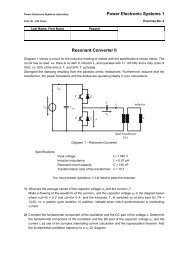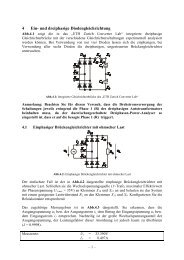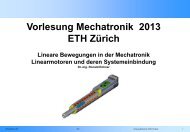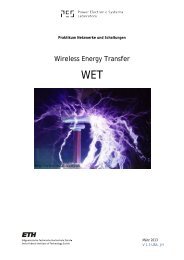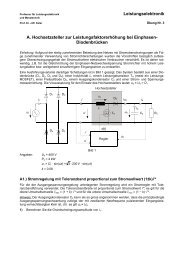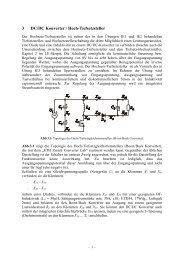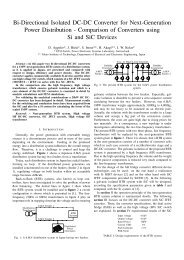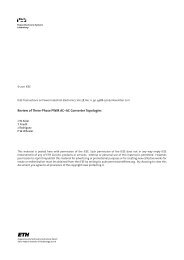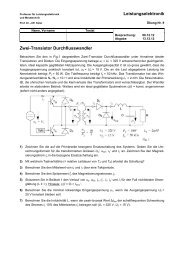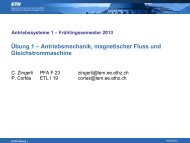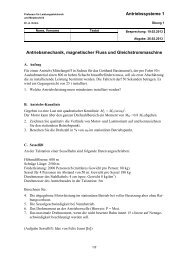U. Badstübner, J. Biela, J. W. Kolar, Power Density and Efficiency ...
U. Badstübner, J. Biela, J. W. Kolar, Power Density and Efficiency ...
U. Badstübner, J. Biela, J. W. Kolar, Power Density and Efficiency ...
You also want an ePaper? Increase the reach of your titles
YUMPU automatically turns print PDFs into web optimized ePapers that Google loves.
<strong>Power</strong> density [kW/ltr.]<br />
20<br />
15<br />
10<br />
<br />
<br />
CTC<br />
<br />
CDR<br />
SPR-C<br />
5<br />
30 50 100 300 500 1000<br />
Frequency f [kHz]<br />
<strong>Efficiency</strong> [%]<br />
98<br />
96<br />
<br />
94<br />
92<br />
<br />
SPR-C<br />
<br />
CDR<br />
CTC<br />
90<br />
30 50 100 300 500 1000<br />
Frequency f [kHz]<br />
Figure 4: <strong>Power</strong> density <strong>and</strong> efficiency of the series-parallel<br />
resonant converter with capacitive output (SPR-C), phase-shift<br />
converter with current doubler (CDR) <strong>and</strong> capacitive output<br />
(CTC) in dependency of the switching frequency.<br />
optimization. There, also the flux distribution/saturation <strong>and</strong><br />
HF-losses as skin- <strong>and</strong> proximity-effect losses are considered.<br />
This results, e.g. in an optimal foil thickness of ≈65 µm for<br />
the primary winding <strong>and</strong> ≈150 µm for the secondary winding.<br />
d<br />
c<br />
CDR<br />
a<br />
L S1<br />
b<br />
c d a<br />
a/2<br />
SPR-C<br />
L S2<br />
c<br />
a/2<br />
b<br />
d<br />
c d a<br />
c<br />
a<br />
b<br />
a<br />
a/2<br />
b<br />
e<br />
c<br />
d<br />
c<br />
b<br />
a<br />
a<br />
Distributed Air Gaps<br />
e<br />
CTC<br />
Figure 5: Dimensions of the transformer cores <strong>and</strong> the inductors<br />
(for the CDR) resulting from the optimization procedure<br />
for the series-parallel resonant converter with capacitive output<br />
(SPR-C), phase-shift converter with current doubler (CDR)<br />
<strong>and</strong> capacitive output (CTC).<br />
A. Simulation Results<br />
With the system parameters resulting from the optimization<br />
procedure (cf. table III) simulation models of the converters<br />
have been developed in Simplorer (Ansoft). The characteristic<br />
simulated waveforms are shown in Fig. 6. The corresponding<br />
values resulting from the simulation are given in brackets in<br />
table III, where a good correspondence between analytical<br />
model <strong>and</strong> simulation can be seen. The slight differences<br />
are caused by the fact, that in the simulation more parasitic<br />
elements are considered.<br />
Based on the simulation results, which confirm the analytical<br />
optimization, prototypes of the converters can be designed.<br />
Some details of these prototypes will be presented in the<br />
following section.<br />
V. PROTOTYPES AND MEASUREMENT RESULTS<br />
Based on the optimization results a prototype of the seriesparallel<br />
resonant converter has been constructed (cf. Fig. 1a<br />
<strong>and</strong> 7).<br />
CDR<br />
CTC<br />
SPR-C<br />
400<br />
200<br />
0<br />
-200<br />
-400<br />
0 1 2 3 4 5 6 7 8 9<br />
I Off,B<br />
I 400<br />
Off,A<br />
V AB<br />
200<br />
0<br />
-200<br />
-400<br />
I Off,B<br />
Vsec<br />
V sec<br />
I Off,A<br />
10.I P<br />
0 1 2 3 4 5 6 7 8 9 10 11 12 13 14 15 16 17<br />
I Off,B<br />
400<br />
I V AB<br />
200<br />
Off,A<br />
0<br />
-200<br />
-400<br />
V CP<br />
V AB<br />
10.I P<br />
10.I P<br />
0 1 2 3 4 5 6 7 8 9 10 11 12 13 14<br />
Time t in [µsec]<br />
Figure 6: Simulated curves of V AB , I P , V sec <strong>and</strong> V Cp (cf.<br />
Fig. 1b) <strong>and</strong> Fig. 2) for the three presented converter with the<br />
parameters resulting from the optimization procedure.<br />
This 5 kW prototype has a volume of 0.49 ltr., resulting in<br />
a power density of 167 W/in 3 (10.2 kW/ltr.). With the new<br />
components utilized in the presented optimization this power<br />
density could be increased to approximately 12 kW/ltr.<br />
Besides the optimization of the semiconductor heat sink,<br />
the integration of the series inductance L S <strong>and</strong> the cooling<br />
of the magnetic component is very important. The technical<br />
realization of this transformer is illustrated in Fig. 8. The<br />
leakage inductance is generated in the top leg by the insertion<br />
of distributed air gaps. Since the H-field would result in eddycurrents<br />
in the heat transfer component (HTC) of the primary<br />
winding/leakage leg, slots are milled into the HTC in the area<br />
over the air gaps. Since the primary winding is enclosing the<br />
leakage flux path the radiated H-field is relatively low with<br />
this design.<br />
Output<br />
Connectors<br />
Transformer<br />
Heat Sink<br />
Output Voltage/Current<br />
Measurement Board<br />
Output Capacitance<br />
C OUT = 500µF<br />
Parallel Capacitance<br />
C P = 120nF<br />
Rectifier<br />
Diodes<br />
Isolated<br />
Heat Sink<br />
Figure 7: Back view of the resonant DC-DC converter prototype.



